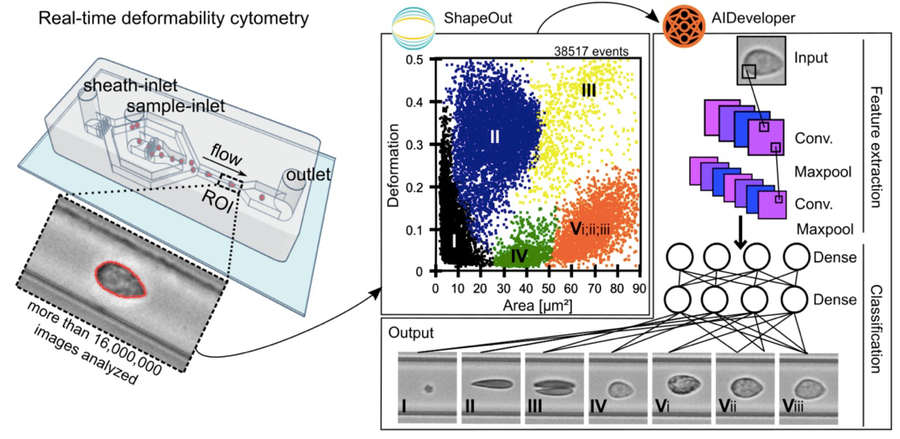For the first time, a study conducted by the TU Dresden and the University of Zurich in collaboration with the Max Planck Institute for the Science of Light finds a relationship between depressive disorders and mechanical features of all main blood cell types.
 Real-time deformability cytometry and subsequent AI-based classification of blood cells. Image Credit: Andreas Walther, CC BY-NC 4.0.
Real-time deformability cytometry and subsequent AI-based classification of blood cells. Image Credit: Andreas Walther, CC BY-NC 4.0.
The findings imply that depressive disorders, particularly persistent depressive disorders, are linked to an increase in immune cell deformability, which might signify impaired cell function and help to explain why many depression patients feel exhausted.
Loss of interest, joylessness, a lack of motivation, and increased fatigability are all common signs of depression, a mental disorder that affects an estimated 5% of the German population. Low-grade inflammation and increased glucocorticoid production are common pathophysiological characteristics of depressive disorders.
Scientists from the Technische Universität Dresden, the University of Zurich, and the Max Planck Institutes for the Science of Light and the Max-Planck-Zentrum für Physik und Medizin Erlangen establish for the first time a correlation between depressive disorders and mechanical changes in blood cells in a new study published in the esteemed journal Translational Psychiatry.
To accomplish so, the experts used image-based morpho-rheological characterization of unmanipulated blood samples to facilitate real-time deformability cytometry (RT-DC) in a cross-sectional case-control study.
The Composite International Diagnostic Assessment, a widely established clinical interview for mental disorders, was used to assess 69 pre-screened patients at high risk for depressive disorders and 70 matching healthy controls. The main blood cell types were categorized and morpho-rheological properties such as cell size and deformability of each cell were measured using the AI technique of deep learning applied to over 16 million blood cell images.
As a result, the researchers discovered that individuals with depressive disorders had more deformable peripheral blood cells than control people, although cell size was unaffected.
Monocytes and neutrophils were more deformable in people who had suffered from persistent depressive disorder in the past, whereas erythrocytes were more deformable in those who were now suffering from a persistent depressive disorder. Individuals with a current depressive condition also had more deformable lymphocytes.
Following that, the study indicates for the first time that depressive disorders, particularly persistent depression disorders that last longer than two years, are linked to increased blood cell deformability. Lymphocytes, monocytes, and neutrophils are the most impacted, while all major blood cells exhibit greater deformability.
This shows that in depressive disorders, mechanical alterations in immune cells occur, which might be the cause of a long-term immunological response. The discovery of this pathomechanism might lead to novel therapeutic options in the future, such as enhancing cell mechanical processes to restore dysfunctional cell function.
It means a lot to the first author Dr Andreas Walther, who conducted the study at the TU Dresden Chair of Biopsychology but is now working at the University of Zurich’s Institute of Clinical Psychology and Psychotherapy, to advance both biological and psychological therapies that treat depressive disorders more effectively and reliably in the long run:
We are working in parallel on research into pharmacological therapies to improve a dysfunctional biology as well as psychological therapies to improve dysfunctional cognitive and emotional processes. Indeed, in my opinion, only a holistic approach can understand and efficiently treat this complex disorder and hopefully prevent much suffering in the future.”
Dr Andreas Walther, Institute of Clinical Psychology and Psychotherapy, University of Zurich
Source:
Journal reference:
Walther, A., et al. (2022) Depressive disorders are associated with increased peripheral blood cell deformability: a cross-sectional case-control study (Mood-Morph). Translational Psychiatry. doi.org/10.1038/s41398-022-01911-3.